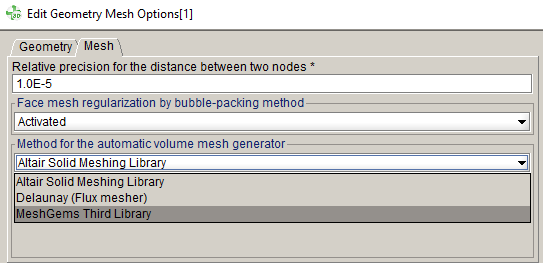Since version 2026, Flux 3D and Flux PEEC are no longer available.
Please use SimLab to create a new 3D project or to import an existing Flux 3D project.
Please use SimLab to create a new PEEC project (not possible to import an existing Flux PEEC project).
/!\ Documentation updates are in progress – some mentions of 3D may still appear.
Meshing of volumes algorithms
Introduction
Flux provides two generators for automatic meshing of volumes: the ASML mesher and the Delaunay mesher.
The two meshers are presented in the blocks below.
ASML mesher
The ASML Mesher (Altair Solid Meshing Library) is a volume mesher which is the proprietary of Altair. This is a mesher of volume mesh starting from a surface mesh. Including ASML allows to generate tetrahedral mesh of volume from a mesh of surface triangular.
Delaunay mesher
The mesh generation by the Delaunay mesher is carried out in two phases, as presented in the table and figure below.
| Stage | Description |
|---|---|
| 1 | Generation of boundary mesh |
| 2 | Insertion of internal nodes into border mesh elements |
Comparison
Comparison of Volume mesh generators is presented in the table below| Delaunay | ASML (Altair Solid Mesher Library) | |
|---|---|---|
| Characteristics |
|
|
|
Advantages / disadvantages |
|
|
Configure the mesher
To configure the volume mesher:
- clic on:
- clic on tab Mesh
- choose the mesher
